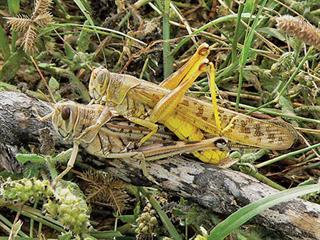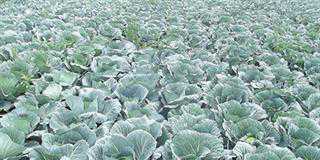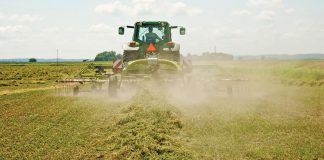
Locust swarms can extend for several kilometres, with each square kilometre containing upwards of 80 million individuals. Some swarms are so large they can be tracked by radar. It is no wonder that the impact on crops is devastating – a large swarm can consume 20 000t of food a day, leaving behind a barren land.
The locust is the ‘swarming phase’ of certain short-horned grasshoppers in the family Acrididae. Or as Hugh Dingle puts it in Migration: The Biology of Life on the Move, the term ‘locust’ is used for grasshopper species that change physically and behaviourally, forming migratory swarms from bands of immature stages called hoppers.
The mechanism that triggers the swarming instinct was unknown, until researchers at Oxford University spent weeks gently touching various parts of the locust’s body with a fine paintbrush at different times of the day and at different temperatures. They eventually discovered the trigger area: certain hairs on the rear legs. As the grasshoppers increase in number and crowd together, they brush against each locusts. This is a signal to swarm and seek food.
As a result, the grasshoppers change colour, usually becoming darker with strongly contrasting yellow and black markings. They also grow bigger and breed faster. The resulting swarm behaves like a single organism and may move over tens of kilometres in a few weeks, pausing to feed at intervals.
Terminology
The initial bands of gregarious hoppers are known as ‘outbreaks’. An ‘upsurge’ occurs when these join together into larger groups. Upsurges from different locations join together to form a ‘plague’. Interestingly, as the group becomes larger, the area it attacks becomes smaller. For example, in the desert locust plague in Africa, the Middle East and Asia that lasted from 1966 to 1969, the number of locusts increased fifteen-fold to 30 billion over two generations, but the area covered decreased from approximately 100 000km² to just 5 000km².
Methods of prevention
In a study undertaken in 1994 by the Botswana government and the US Agency for International Development, researchers put forward the following recommendations for preventing locust intrusions:
- Plant more resistant varieties of crops. For example, sorghum is more resistant to attack from locusts than millet;
- Plant crops that develop at different rates and times;
- Rotate crops;
- Introduce biological control (conservation or augmentation of natural enemies already present or introduced).
Control
In small numbers, locusts and grasshoppers can be physically removed from plants and crops. Though effective, this is time-consuming and labour-intensive. Natural predators such as lizards, birds, spiders and parasitoids are also effective in controlling reasonable numbers of the pest. An upsurge or plague is entirely different – no number of natural predators can help.
For a long time, the most effective means of control was approved commercial pesticides. But there are environmental concerns with these. Fortunately, advances in technology are leading to different lines of management.
For example, a fungal pathogen called Beauvaria bassiana has been tested in parts of Africa with some success. Species-specific pathogens are also under investigation: these target a particular species and do not kill important parasitoids or pollinators.
(Please note: this series is intended primarily as a guide to identifying pests. For help with area- or crop-specific measures, please consult your agricultural extension officer.)
Sources: Hugh Dingle, Migration: the Biology of Life on the Move (Oxford University Press, 1996); Morgan, James: ‘Locust swarms “high” on serotonin’, BBC News.
Paul Donovan is a Botswana-based biologist.













